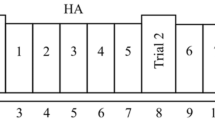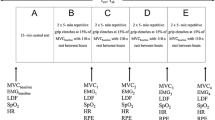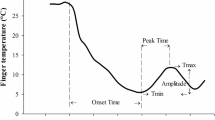Abstract
The influence of cold (+5° C), room temperature (+22° C) and hot (+75° C) air exposures on post-activation effects (PAE) in brachial biceps (BBs) and triceps (TBs) muscles were investigated bilaterally in six male subjects. PAE were evoked by 1 min volitional isometric contraction (VIC) at submaximal level in BBs by holding an inertial weight by palms, with right-angled elbows. At room temperature, average EMG during PAE (PAEav) usually was 2–4% and the integral of EMG (PAEint) was 3-7% of that of VIC respectively. PEA duration was 1–6 min. Cold exposure evoked an approximately two-fold increase of PAEintt (P < 0.01). Hot exposure decreased PAEint, (P < 0.01) and shortened PAE duration by approximately 50% (P < 0.01). In two subjects, long- term modulation of EMG intensity during PAE was observed. Cold increased the frequency and amplitude of these waves, while heat decreased them. In two subjects, alternation of BBs and TBs in EMG activity during PAE was observed. The data obtained suggest that postactivation of muscles strongly depends on the environmental temperature.
Similar content being viewed by others
References
Abeuova G, Tleulin S, Chemeris A, Abuziarova M, Ibragimova S (1992) The interrelationship of pain and temperature reception in human skin (in Russian, summary in English) Neirofiziologiia 24:604–611
Cabanac M (1979) Le compotrement thermoregulateur. J Physiol (Paris) 75:115–178
Craske B, Craske J (1985) Muscular aftercontraction reveals oscillator mechanisms in the human motor apparatus. Hum Mov Sci 4:249–269
Craske B, Craske J (1986) Oscillator mechanisms in the human motor system: investigating their properties using the after- contraction effect. J Mot Behav 18:117–145
Eldred E, Hagbaarth KE (1954) Facilitation and inhibition of gamma efferents of stimulation of certain skin areas. J Neurophysiol 17:50–65
Euler C von, Söderberg MK (1957) The influence of hypo- thalamic thermoreceptive structures on the electroencephalogram and gamma motor activity. Electroencephalogr Clin Neurophysiol 9:391–408
Gurfinkel VS, Levic Y, Lebedev MA (1989) Immediate and remote postactivation effects in the human motor system (in Russian, summary in English). Neirofiziologiia 21:343–351
Hagbarth KE (1952) Excitatory and inhibitory skin areas for flexor and extensor motoneurones. Acta Physiol Scand 26 (Suppl 94) 1–58
Kleinbeckel D, Klussman FK (1990) Shivering. In: Schönbaum E, Loma P (eds) Thermoregulation: physiology and biochemistry. Pergamon. New York, pp 235 252
Klussmann FW (1964) The influence of temperature on the activity of spinal alpha and gamma-motoneurons. Experientia 20:450–454
Kohnstamm O (1915) Demonstration einer katatonieartigen Erscheinung beim Gesunden (Katatonusversuch). Neurol Zentralbl 34:290–291
Latash ML, Gurfinkel VS (1986) Vibration tonic reflex and body position (in Russian). Fiziol Cheloveka 12:164 172
Lupandin Y, Antonen EG, Meigal A (1993) Patterns of bio- electrical activity of motor units in different clinical forms of Parkinsonism (in Russian, summary in English). Zh Nevropatol Psikiatr 93:30–34
Meigal A, Lupandin Y, Kuzmina GV (1993) Electro- myographic patterns of thermoregulatory activity of motor units in the course of body cooling (in Russian) Fiziol Cheloveka 19:106 114
Minut-Sorokhtina OP, Lupandin Y (1984) Modulation of postural tonus by thermoreceptive aflerence. Arch Exper Vet Med (Leipzig) 38:342–246
Person RS. kozhina GV (1989) Investigation of motor units impulsation, activated by muscle vibration (in Russian). Fiziol Cheloveka 15:149–151
Ramanathan NL (1964) A new weighting system for mean surface temperature of the human body. J Appl Physiol 19: 531–533
Ukhtomskii AA (1925) The special type of tonic reactions in human limbs (in Russian). Proc Leningrad Soc Naturalists 56: 115–121
Author information
Authors and Affiliations
Rights and permissions
About this article
Cite this article
Meigal, A.Y., Lupandin, Y.V. & Hänninen, O. Influence of cold and hot conditions on postactivation in human skeletal muscles. Pflügers Arch — Eur J Physiol 432, 121–125 (1996). https://doi.org/10.1007/s004240050113
Received:
Revised:
Accepted:
Issue Date:
DOI: https://doi.org/10.1007/s004240050113




